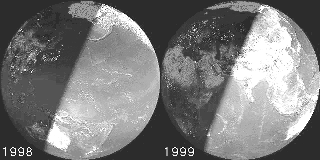
1996-98 Leonid Outburst Event Summary

View on Earth from the perspective of the Leonid shower at the time of
passing the comet node.
Image by Peter Jenniskens, using software by
John Walker.
Satelite data are courtesy The Living Earth, Inc.
RADIANT OF THE METEOR STREAM:
RA = 153.7 degree (J2000)
DEC = +21.9 degree (J2000), in
constellation Leo
V = 71 km/s
Daily motion= +1.0 degree in RA and -0.4 degree in DEC
THE MOON'S PHASE:
1996 - 6 days
1997 - 17 days
1998 - 28 days
1999 - 10 days
Chart of the radiant and Moon conditions in 1997
PATH OF THE EARTH THROUGH THE METEOR STREAM:
The following image
(24K) gives a picture of the path of the Earth through the Leonid meteoroid swarm in the
upcoming return (circles). The image is courtesy of Sky & Telescope and based on
a paper by Yeomans et al. (1981) in ICARUS.
The path of the comet relative to Earth's orbit is found here.
(<<)
ACCORDING TO: PETER BROWN (1997)
Model calculations show that the
most likely time of peak Leonid activity during the next several
years is at a solar longitude of 235.2 +/- 0.05. This solar longitude corresponds
to that of the peak of the 1966 Leonid storm, and is
about 2 hours before the nodal crossing time.
ACCORDING TO: WILLIAM COOKE (1997):
Estimation of meteoroid Fluxes for the 1997-2000 Leonid storms by William Cooke,
CSC/EL23 Marshall Space Flight Center.
ACCORDING TO : LANGBROEK (1997):
Based on recent Leonid observations.
The narrow peak of faint Leonids (Jenniskens 1996) was observed at a time before
the node of the comet orbit. That would put the time of peak activity in 1998 two hours
earlier than predicted before.
ACCORDING TO : BEECH, JONES, BROWN, and WEBSTER (1997):
Based on uncertain, but more extended numerical model of the meteor stream.
Expected pattern of activity:
1997 - no activity
1998 - onset of activity, but maybe too early
1999 - highest activity
2000 - high activity
2001 - still increased activity
2002 - still increased activity
2003 - maybe still increased activity
ACCORDING TO YEOMANS, YAU, AND WEISSMAN (1996):
Based on the orbit of the comet and the passing of the comet's node. The meteor activitymay well be earlier or later.
Earth passes through comet orbit plane:
1996 - Nov. 17 7:20 UT (good for Eastern USA)
1997 - Nov. 17 13:34 UT (good for Western U.S., Hawaii)
1998 - Nov. 17 19:43 UT (good for Japan, Asia)
1999 - Nov. 18 1:48 UT (good for Europe, North Africa)
Earth follows (+) or leads (-) the comet:
1996 - -473 days
1997 - -108 days
1998 - +257 days
1999 - +623 days
ACCORDING TO BEECH, BROWN, JONES, and WEBSTER (1996):
Based on an uncertain numerical model of the meteor stream.
Earth passes solar longitude 235.16 (J2000):
1997 - Nov. 17.32 UT (good for Northern Pacific)
1998 - Nov. 17.71 UT (good for Central Asia)
1999 - Nov. 17.96 UT (good for Central Europe)
ACCORDING TO WU & WILLIAMS (1996):
Based on an uncertain numerical model of the meteor stream.
1998 - Rates similar to 1933, but less than 1966
1999 - Few will be seen
ACCORDING TO JENNISKENS (1996):
Based on general interpretations of past Leonid observations.
Time of peak activity of outburst:
1996 - Nov. 17 7 UT (good for Eastern USA)
1997 - Nov. 17 21 (13h UT) UT (good for Japan, Asia)
1998 - Nov. 17 21 (19.5h UT) UT (good for Thailand, India, China)
1999 - Nov. 18 06 (01.5h UT) UT (good for Eastern USA)
Peak activity (in terms of Zenith Hourly Rate)
1996 - about 100 per hour - rich in bright meteors
1997 - about 200 per hour - rich in bright meteors
1998 - about 10,000 per hour - rich in faint meteors
1999 - about 5,000 per hour - rich in faint meteors
Duration of the outburst
1996 - about 1 day
1997 - about 1 day (with narrow component of faint meteors
1998 - about 3 hours (with broader background)
1999 - about 3 hours (with broader background)
OLDER PREDICTIONS ARE NOT LISTED HERE, because they are thought tobe even less certain.
(<<)
In 1998:
- Time of peak:
18 - 23 h Universal Time (UT), most likely around 19.7h UT = 11.7 h PST = 2.7h Bangkok, Thailand.
- Expected meteor rates:
2000-10,000 meteors/hr per visual observer (peak at early morning hour: radiant in the zenith). Possible peak range: 100 (no storm) - 20,000
- Dust density outside atmosphere:
- Duration of the shower:
2x 1/e duration = 0.7 hours, total about 1.5 hours.
- Activity curve:
exponential increase and decrease of rates with time.
- Magnitude distribution index:
3.0±0.2 (numbers increase by factor 3 every magnitude)
- Best observing locations:
21±40 degree North, 120±45 degree East, best over China, Japan?, Phillipines, Vietnam and Thailand
- Radiant high enough above the local horizon at Latitute +15N:
- Hours of dark sky:
until beginning of astronomical twilight
- Moon:
In 1999:
- Time of peak:
0-5 h Universal Time (UT), most likely around 1.7h UT
- Expected meteor rates:
2000-10,000 meteors/hr per visual observer (peak at early morning hour: radiant in the zenith). Possible peak range: 100 (no storm) - 100,000
- Dust density outside atmosphere:
- Duration of the shower:
2x 1/e duration = 0.7 hours, total about 1.5 hours.
- Activity curve:
exponential increase and decrease of rates with time.
- Magnitude distribution index:
3.0±0.2 (numbers increase by factor 3 every magnitude)
- Best observing locations:
21±40 degree North, 30±45 degree East, best over Europe and northern Africa
- Radiant high enough above the local horizon at Latitute +20N:
- Hours of dark sky:
until beginning of astronomical twilight
- Moon:
10 days old, will set during night
(<<)
http://www-space.arc.nasa.gov/~leonid/
Last modified: June 4, 1998
P. Jenniskens
S. Butow 